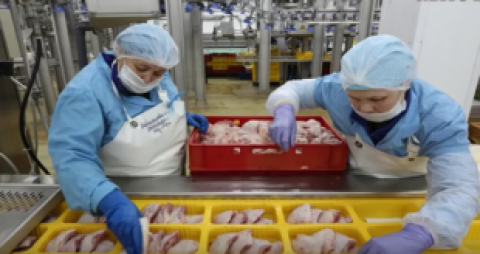“My supervisor let me know that if my hands hurt and I go see the nurse, I should tell her that the pain comes from something that happened at home. I shouldn’t say it’s work-related. If I say my pain comes from something I did at work, then I will be laid off without pay and three days later get fired. So, when I go to the nurse I tell her that I hurt my hands at home.”
That's testimony from Diane, a 38-year-old African-American woman using a pseudonym. She was interviewed for a new report , put out by the Southern Poverty Law Center, which details the daily realities of poultry workers in Alabama. Against the advice of her supervisor, Diane secretly saw a doctor and was diagnosed with carpal tunnel syndrome. "Diane’s story is not unique," notes the report, "Company policies requiring workers to see plant nurses first, even threatening discipline if workers initially seek outside treatment, are prevalent throughout the industry."
The SPLC report, "Unsafe at These Speeds," paints the picture of a flourishing industry sustained by tremendous exploitation of both humans and birds. The average American consumes about 50 pounds of chicken a year and the industry accounts for about 10% of Alabama's entire economy. Almost three-quarters of the workers interviewed by SPLC said they had suffered a significant workplace injury or illness.
Despite these staggering statistics, the U.S. Occupational Safety and Health Administration only reported an injury rate of 5.9% for poultry workers in 2010. That's over 50% higher than the injury rate for all United States workers, but doesn't come close to quantifying the problems detailed in SPLC's findings.
Shortly after releasing the report, SPLC filed a federal safety complaint with OSHA. The complaint targets Farm Fresh Foods, a poultry plant in Guntersville, Alabama that allegedly fired two workers who blew the whistle on dangerous and unsanitary workplace conditions at the facility. A statement put out by SPLC details what led to the workers' whistleblowing:
The whistleblowers worked in Farm Fresh’s third-shift sanitation crew, cleaning the processing plant at night. At the end of their shift, supervisors required them to unload raw chicken from crates onto the processing line for the next shift. They did not, however, allow the workers to wash their hands or change out of the soiled clothes and gloves they wore to clean the plant. Workers raised concerns about contaminating the chicken, but they were routinely ignored.
The complaints also describes how workers were denied bathroom breaks outside of their sole 30-minute break per eight-hour shift—an epidemic problem in the poultry industry that leads some workers to wear diapers . Even when workers at Farm Fresh Foods were given permission to use the bathroom, a supervisor would often stand outside the restroom and time their breaks.
Three days after SPLC filed the complaint, OSHA cited Pilgrim’s Pride, a poultry facility in Live Oaks, Florida, for consistently delaying appropriate medical care to workers who are injured on the job. It's the first time OSHA has ever cited a company for such a violation. In a statement , National Employment Law Project's Deborah Berkowitz commended the step but pointed out that the problem transcends Pilgrim's Pride:
Unfortunately, the issues found at the Pilgrim’s Pride plant are all too common throughout the industry. In a plant in Alabama OSHA found workers visited the "health unit" over 90 times requesting medical treatment, but were denied every time. At another plant in Delaware, OSHA found the company had turned its first aid station into an office to prevent workers from reporting an injury altogether. In these plants, workers are not allowed to seek medical treatment without the companies’ permission—otherwise they are penalized and written up, which can lead to job loss.
The SPLC report points out that some of these injuries occur because there is no state or federal line speed regulation developed to protect workers. In fact, the U.S. Department of Agriculture is continually monitoring line speeds and could increase the speed of the processing. Tony Corbo, of Food & Water Watch, broke down the details for AlterNet:
As it stands right now, the maximum line speed in poultry slaughter is 140 birds per minute in chicken slaughter with the exception of the 20 plants that were part of a pilot program called HIMP (HACCP-based Inspection Models Project) that started in the late 1990’s. These plants can run up to 175 birds per minute.The Obama Administration, in January 2012, proposed a rule that would have permitted most chicken plants to move to 175 birds per minute if they came under the New Poultry Inspection System (NPIS). Because there was such a controversy over that rule, the final rule only permitted the HIMP plants to continue at 175 birds per minute. Every other plant converting to NPIS could only run at 140 bpm, but USDA officials have testified that they are continually evaluating the line speed issue and could propose in the future increasing the line speed to 175 across the board.
So while a shift in OSHA regulations would be welcomed, safety advocates are conscious of the fact real reform could be stifled by powerful forces in Washington. What's more, there are valid concerns about how OSHA would enforce such rules. Some workers interviewed said conditions became more dangerous after an OSHA inspection had taken place because the facility had reduced the speed of the line while inspectors were on the floor. Once OSHA left, the speed was increased to a greater level to compensate for the lost production.
Naomi Tsu, deputy legal director at SPLC, released a statement on the OSHA citation. " will continue to advocate for [these workers] until everyone employed in this industry can go to work without fearing for their safety.”
Michael Arria is an associate editor at AlterNet and the author of Medium Blue: The Politics of MSNBC . Follow @MichaelArria on Twitter.


Spread the word